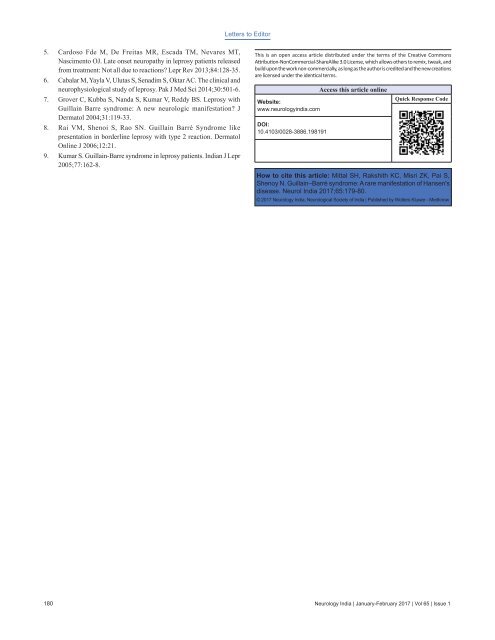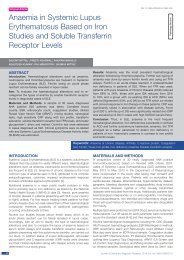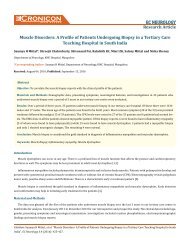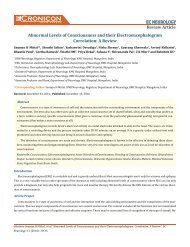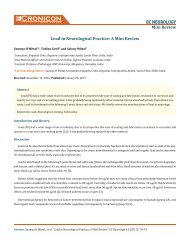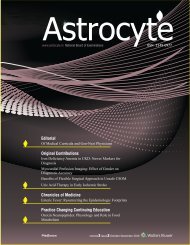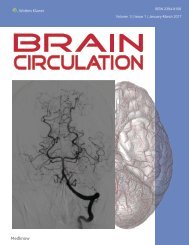Guillain–Barré syndrome A rare manifestation of Hansen’s ds disease
You also want an ePaper? Increase the reach of your titles
YUMPU automatically turns print PDFs into web optimized ePapers that Google loves.
Letters to Editor<br />
5. Cardoso Fde M, De Freitas MR, Escada TM, Nevares MT,<br />
Nascimento OJ. Late onset neuropathy in leprosy patients released<br />
from treatment: Not all due to reactions? Lepr Rev 2013;84:128‐35.<br />
6. Cabalar M, Yayla V, Ulutas S, Senadim S, Oktar AC. The clinical and<br />
neurophysiological study <strong>of</strong> leprosy. Pak J Med Sci 2014;30:501‐6.<br />
7. Grover C, Kubba S, Nanda S, Kumar V, Reddy BS. Leprosy with<br />
Guillain Barre <strong>syndrome</strong>: A new neurologic <strong>manifestation</strong>? J<br />
Dermatol 2004;31:119‐33.<br />
8. Rai VM, Shenoi S, Rao SN. Guillain Barré Syndrome like<br />
presentation in borderline leprosy with type 2 reaction. Dermatol<br />
Online J 2006;12:21.<br />
9. Kumar S. Guillain‐Barre <strong>syndrome</strong> in leprosy patients. Indian J Lepr<br />
2005;77:162‐8.<br />
This is an open access article distributed under the terms <strong>of</strong> the Creative Commons<br />
Attribution‐NonCommercial‐ShareAlike 3.0 License, which allows others to remix, tweak, and<br />
build upon the work non‐commercially, as long as the author is credited and the new creations<br />
are licensed under the identical terms.<br />
Website:<br />
www.neurologyindia.com<br />
DOI:<br />
10.4103/0028-3886.198191<br />
PMID:<br />
xxxx<br />
Access this article online<br />
Quick Response Code<br />
How to cite this article: Mittal SH, Rakshith KC, Misri ZK, Pai S,<br />
Shenoy N. <strong>Guillain–Barré</strong> <strong>syndrome</strong>: A <strong>rare</strong> <strong>manifestation</strong> <strong>of</strong> Hansen's<br />
<strong>disease</strong>. Neurol India 2017;65:179-80.<br />
© 2017 Neurology India, Neurological Society <strong>of</strong> India | Published by Wolters Kluwer - Medknow<br />
Novel SCN8A mutation in a girl with refractory<br />
seizures and autistic features<br />
Sir,<br />
A 4‐year‐old girl presented with speech delay and refractory<br />
seizures. She had no adverse perinatal events, had normal<br />
motor milestones, and could speak only a few bisyllables.<br />
She had seizures since 4 months <strong>of</strong> age. Initially, she had<br />
generalized tonic–clonic seizures (2–3 episodes/week) and<br />
required multiple anticonvulsant drugs (phenytoin, valproate,<br />
lamotrigine, clobazam, and levetiracetam). After 14 months <strong>of</strong><br />
age, she experienced nocturnal tonic seizures (2–3 times/week)<br />
and atypical absences (2–3/day), which continued until her<br />
admission to our hospital. The seizures were only occasionally<br />
associated with fever. In addition to having seizures, she<br />
had autistic features (Childhood Autism Rating Scale score<br />
<strong>of</strong> 32). Her physical examination was unremarkable. Magnetic<br />
resonance imaging (MRI) <strong>of</strong> the brain was normal. Interictal<br />
electroencephalogram (EEG) showed a slow background<br />
activity with right frontopolar spike‐wave discharges.<br />
Karyotype, array comparative genomic hybridization, plasma<br />
acylcarnitine pr<strong>of</strong>ile, and urine organic aci<strong>ds</strong> were normal. Next<br />
generation sequencing for epilepsy genes [Table 1] revealed a<br />
novel pathogenic heterozygous missense mutation (c.4214C>A;<br />
p.Ala1405Asp) in the exon 22 <strong>of</strong> the SCN8A gene. Both the<br />
parents were negative for this variant. She was again started<br />
on phenytoin with resolution <strong>of</strong> tonic seizures, persistence <strong>of</strong><br />
atypical absences, and appearance <strong>of</strong> daily head‐drops. She was<br />
started on modified Atkins diet. However, it had to be stopped<br />
after 25 days in view <strong>of</strong> poor compliance and oral acceptance<br />
by the child. Behavioural therapy was initiated and genetic<br />
counselling was done.<br />
Mutations in SCN8A, encoding one <strong>of</strong> the main voltage‐gated<br />
sodium channel subunits (Nav1.6) in the brain, have been<br />
recently described in patients with severe epilepsy and the<br />
phenotype is still evolving. [1,2] Seventeen patients with de novo<br />
heterozygous mutations <strong>of</strong> SCN8A were recently reported.<br />
[2]<br />
The phenotype comprised variable intellectual disability,<br />
drug‐refractory epilepsy, autistic features, and prominent<br />
motor <strong>manifestation</strong>s (hypotonia, dystonia, hyperreflexia, and<br />
ataxia). The mean age at the onset <strong>of</strong> seizures was 5 months<br />
and the reported seizure types included focal, tonic, clonic,<br />
myoclonic, atypical absence seizures, epileptic spasms, and<br />
febrile seizures. Thus, the genetic testing for SCN8A should<br />
be considered in children with unclassified severe epilepsy.<br />
This may have a therapeutic implication. Four patients with a<br />
missense SCN8A mutation and epilepsy were reported to have<br />
a remarkably good response on high doses <strong>of</strong> phenytoin, and<br />
loss <strong>of</strong> seizure control when the phenytoin medication was<br />
reduced. [3] Our patient showed resolution <strong>of</strong> tonic seizures with<br />
phenytoin; however, the other seizure types were unaffected.<br />
Due to the recent advances in targeted next‐generation<br />
sequencing panels for epileptic encephalopathy/epilepsy,<br />
the diagnostic yield for an underlying genetic abnormality<br />
has increased in patients with epileptic encephalopathy. The<br />
diagnostic yiel<strong>ds</strong> have been reported to be between 10 and 48.5%<br />
in the literature for the 35 to 265 gene panels. [4] This technique<br />
has helped us to achieve a diagnosis in the present case.<br />
Table 1: Next Generation Sequencing for epilepsy gene panel<br />
ADSL, PMM2, ARX, PNKP, SCN2A, PLCB1, SCN8A, KCNT1,<br />
GABRA1, GRIN2B, CDKL5, SLC25A22, STXBP1, SPTAN1, SCN1A,<br />
KCNQ2, PCDH19, ARHGEF9, GABRG2, GABRB3, CACNA1H,<br />
GRIN2A, SCN1B, GABRD, SCN9A, CACNB4, CLCN2, SLC2A1,<br />
EFHC1, ALDH7A1, CHD2, SCN2A, KCNQ3, MECP2, MEF2C,<br />
FOXG1, CHRNA4, CHRNB2, CHRNA2, DEPDC5, CNTNAP2, LGI1,<br />
CPA6, KCNMA1, SRPX2, KCNJ10, PNPO, SLC9A6 (48)<br />
180 Neurology India | January-February 2017 | Vol 65 | Issue 1


